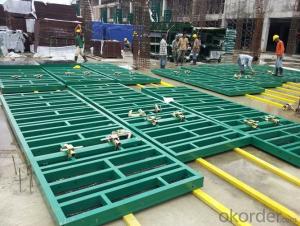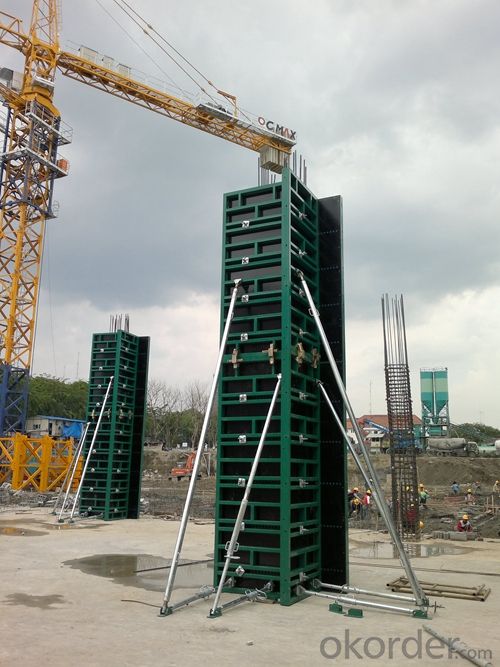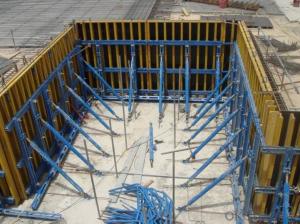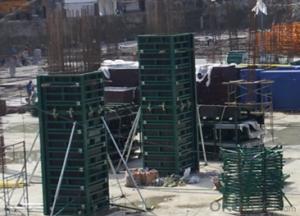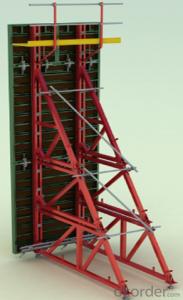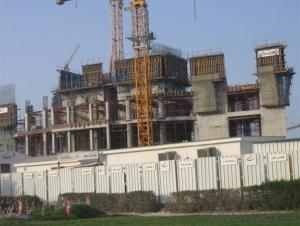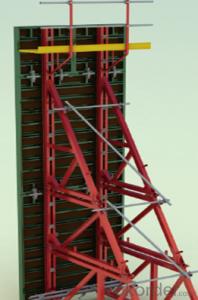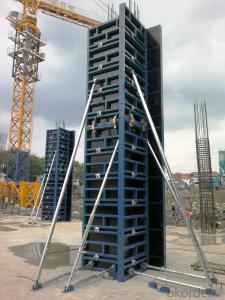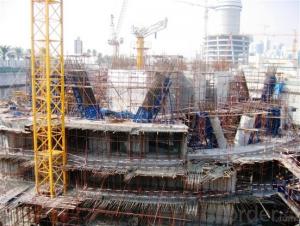CNBM STEEL FRAMED FORMWORK FOR CONSTRUCTIONS
- Loading Port:
- Shanghai
- Payment Terms:
- TT OR LC
- Min Order Qty:
- 1 m²
- Supply Capability:
- 100000 m²/month
OKorder Service Pledge
OKorder Financial Service
You Might Also Like
1. Structure of 120 Steel Framed Formwork Description
Single-side bracket is a kind of formwork for the concrete pouring of single-side wall. The construction is easy and fast. The components have good standard performance and versatility. The pouring height is adjustable, the maximum height of a single pouring is 8.9m.The formwork is always used in the concrete pouring of basement, subway, Sewage treatment factory and so on. The waterproof of the finished wall is excellent
2. Main Features of 120 Steel Framed Formwork
-easy to assemble
-simple structure.
-and convenient for transportation
-convenient for storage.
3. 120 Steel Framed Formwork Images
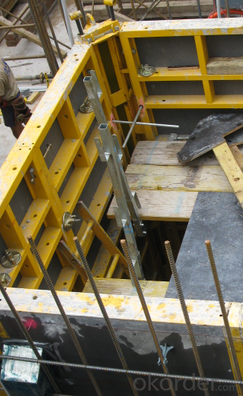

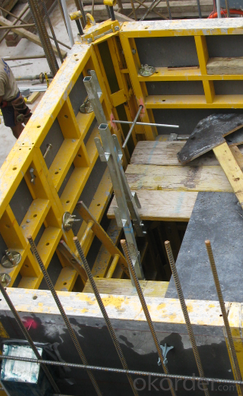
4. Single-side Steel Framed Formwork Specifications
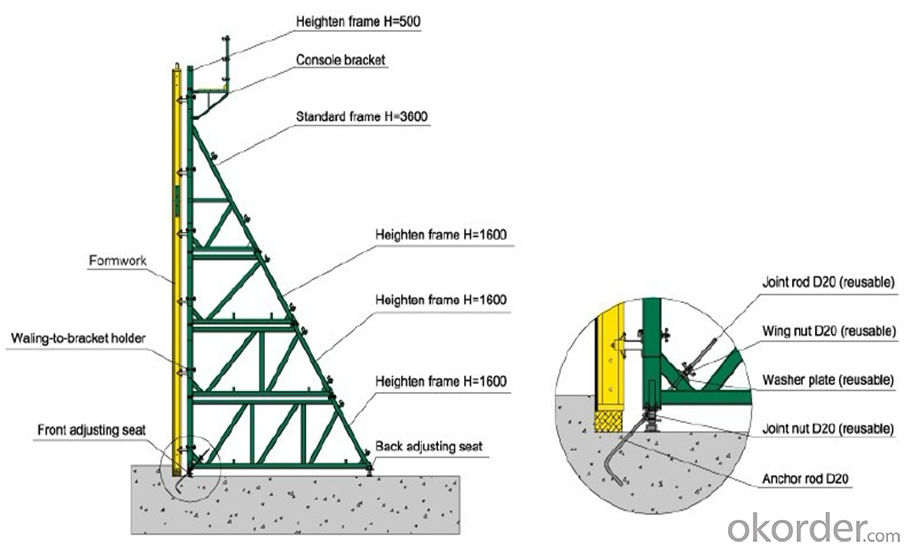
5.FAQ of 120 Steel Framed Formwork
1) What can we do for you?
.We can ensure the quality of the 120 steel framed formwork and avoid extra expenses for customers.
.We can provide you the professional technical team.
.We can provide professional building proposal for your project.
. Please feel free to customize.
2) What promises can be done by us?
. If interested in single side steel framed formwork, please feel free to write us for any QUOTE.
. If need any technical and building assistance, we could provide on-site professional staff for instruction.
. Please DO check goods when courier knocks your door and contact us asap if any issueS.
3) What about of our after-sale service?
. Response will be carried out in 24hours after receiving any complain or request.
. Single side steel framed formwork cost can be refund after order is confirmed.
. If the products are not based on the requirements, there will be the relevant compensations made for you.
4) What about the package and shipping time?
.Packing: wood package and
.Shipping: by sea
Shipping time: Normally small orders, it just1week business days to arrive your hand; When comes to the customs declaration, it may need 2 weeks.
- Q: How does steel frame formwork affect the overall dimensional accuracy of a concrete structure?
- The dimensional accuracy of a concrete structure can be greatly influenced by the use of steel frame formwork. By providing a strong and sturdy framework, steel frame formwork helps to maintain the desired shape and dimensions of the structure throughout the pouring and curing process. One of the major benefits of steel frame formwork is its resistance to deformation and ability to maintain stability. This means that the formwork will not bend or distort under the pressure of the concrete, ensuring that the structure retains its intended shape and dimensions. This is particularly important for structures with complex shapes or specific dimensional requirements. Moreover, steel frame formwork allows for precise adjustments and alignment during construction. The formwork can be easily modified to ensure accurate dimensions that comply with the design specifications. This level of precision is crucial for structures that require close tolerances or have specific dimensional requirements. The use of steel frame formwork also helps to minimize common issues such as formwork deflection or bulging, which can negatively affect the dimensional accuracy of the structure. The strength and rigidity of the steel frame formwork prevent any unwanted movement or deformation, ensuring that the concrete cures evenly and maintains its intended shape. In summary, steel frame formwork greatly enhances the dimensional accuracy of a concrete structure. Its stability, resistance to deformation, and ability to facilitate precise adjustments and alignment during construction reduce the risk of dimensional errors. By providing a solid framework, steel frame formwork guarantees that the final structure meets the desired shape and dimensions specified in the design.
- Q: How is steel frame formwork dismantled after concrete curing?
- Steel frame formwork is typically dismantled after concrete curing by removing the formwork panels and props. The panels are carefully unclamped and lifted away from the concrete structure using cranes or other lifting equipment. The supporting props are then removed, ensuring the structure's stability is maintained throughout the process. This dismantling method allows for the easy and efficient removal of the steel frame formwork, leaving behind a solid and robust concrete structure.
- Q: Can steel frame formwork be used for complex architectural designs?
- Indeed, complex architectural designs can benefit from the utilization of steel frame formwork. This adaptable and versatile system can be tailored to accommodate a multitude of shapes and sizes. By providing the essential strength and stability required, it allows for the molding of concrete into intricate architectural designs. The steel frames can be effortlessly modified and interconnected to form elaborate forms, curves, and angles, enabling the realization of extraordinary and demanding architectural structures. Moreover, steel frame formwork is long-lasting, capable of being reused, and resilient enough to withstand the immense pressure and weight of concrete, rendering it an ideal choice for precision and stability in complex architectural designs.
- Q: Can steel frame formwork be used in combination with sustainable building materials?
- Yes, steel frame formwork can be used in combination with sustainable building materials. Steel frame formwork is a versatile and durable construction system that can be used to create the framework for various sustainable building materials such as bamboo, reclaimed wood, or recycled plastic lumber. These sustainable materials can be incorporated into the formwork system to create eco-friendly structures. Using steel frame formwork in combination with sustainable building materials offers several advantages. Firstly, steel is a highly recyclable material, so it aligns well with sustainable practices. Additionally, steel frame formwork provides structural stability and strength, allowing for the use of lightweight sustainable materials that may not have the same load-bearing capacity. Furthermore, the combination of steel frame formwork and sustainable building materials can contribute to energy efficiency and reduced environmental impact. For example, incorporating insulation materials made from recycled materials or natural fibers can improve the thermal performance of the building, reducing the need for heating or cooling energy. It is important to note that while steel frame formwork can be used with sustainable building materials, the overall sustainability of a construction project depends on various factors such as the sourcing, manufacturing, and transportation of materials, as well as the design and construction methods employed. Therefore, careful consideration should be given to ensure that all aspects of the project align with sustainable principles.
- Q: What are the different types of formwork bracing used in steel frame formwork systems?
- Steel frame formwork systems utilize various types of formwork bracing to ensure stability and support. Each type serves a specific purpose in maintaining the formwork structure. Vertical bracing is employed to provide vertical support and resist vertical loads, preventing deformation or collapse. These braces are placed at regular intervals along the formwork's height to ensure stability and prevent sagging or bulging. Horizontal bracing, on the other hand, offers lateral support to counter horizontal forces like wind or concrete pressure. It prevents any formwork movement or buckling. Horizontal braces are regularly spaced along the formwork's width, ensuring overall stability and preventing distortion. Diagonal bracing serves both vertical and lateral support, resisting the combined forces of vertical and horizontal loads. It enhances stability, preventing deformation or collapse. Diagonal braces are installed in a diagonal pattern, connecting vertical and horizontal bracing elements. This creates a triangulated structure, increasing the overall strength and rigidity of the formwork. Kicker bracing provides additional support and stability, particularly at corners or edges with higher stresses or bending moments. Kickers are placed diagonally from the bottom of the formwork to the ground or a solid anchor point. They offer extra resistance against movement or displacement. Tie rods and anchor bracing secure the formwork system to the surrounding structure, such as columns or walls. They transfer forces and loads from the formwork to the supporting structure, ensuring stability and preventing detachment or failure. Tie rods are embedded within the concrete and connected to the formwork, while anchor bracing is attached to the adjacent structure, creating a strong and secure connection. Overall, the combination of these different formwork bracing types guarantees the stability, integrity, and safety of the steel frame formwork system. This enables efficient construction processes and successful concrete pouring.
- Q: Can steel frame formwork be easily dismantled and recycled?
- Steel frame formwork is capable of being dismantled and recycled without difficulty. Steel, being a material that can be recycled efficiently, is the primary component of the formwork system. The design of the steel frame formwork allows for simple disassembly. Typically, the formwork system comprises of modular steel frames and panels that can be effortlessly removed and reconfigured for future construction endeavors. Once disassembled, the steel frame formwork can be transported to a recycling facility where it will be melted down and repurposed to create new steel items. By engaging in this recycling process, waste is minimized, and natural resources are conserved. Consequently, steel frame formwork presents itself as a sustainable and ecologically sound alternative within the construction industry.
- Q: How does steel frame formwork handle the placement of concrete in vertical or inclined structures?
- Steel frame formwork is a versatile and efficient system used for the placement of concrete in vertical or inclined structures. It offers several advantages over traditional formwork systems, making it the preferred choice for many construction projects. One of the key features of steel frame formwork is its ability to handle the placement of concrete in vertical or inclined structures with ease. The steel frames are designed to be strong and rigid, providing excellent support and stability during the pouring and curing process. This ensures that the concrete is properly contained and does not leak or spill out, resulting in a high-quality finished product. The steel frames are also adjustable, allowing for precise positioning and alignment of the formwork in vertical or inclined structures. This is especially important when dealing with complex architectural designs or irregular shapes. The flexibility of the steel frames enables contractors to create custom formwork solutions that meet the specific requirements of the project. Additionally, steel frame formwork is reusable and durable, which makes it a cost-effective solution for multiple construction projects. After the concrete is cured and the formwork is removed, the steel frames can be easily cleaned and prepared for the next use. This not only saves time and money but also reduces waste and promotes sustainability in the construction industry. Furthermore, steel frame formwork can be easily assembled and disassembled, making it a practical choice for projects with tight timelines or limited space. The modular design of the system allows for quick installation and efficient workflow, ensuring that the concrete placement process is completed on schedule. In conclusion, steel frame formwork is a reliable and efficient solution for handling the placement of concrete in vertical or inclined structures. Its strength, adjustability, reusability, and ease of assembly make it an ideal choice for construction projects of all sizes and complexities.
- Q: What are the environmental impacts of using steel frame formwork?
- Using steel frame formwork has both positive and negative environmental impacts. On the positive side, steel frame formwork is a durable and long-lasting material, allowing for multiple reuses. This reduces the need for frequent replacements and minimizes waste generation in construction projects. Additionally, steel is highly recyclable, so it can be melted down and repurposed at the end of its life cycle, reducing the demand for new steel production and its associated environmental impacts. However, there are also negative environmental impacts associated with steel frame formwork. Steel production requires significant amounts of energy and resources, resulting in greenhouse gas emissions and depletion of natural resources. It also generates substantial waste, including slag and air pollutants, which can harm the environment and human health. Moreover, transporting steel frame formwork materials to construction sites leads to additional carbon emissions and pollution. Due to its weight, steel requires more energy for transportation compared to lighter alternatives. This can significantly increase the environmental footprint of using steel frame formwork, especially for projects located far from steel production facilities. In conclusion, steel frame formwork offers durability and recyclability benefits, but its production, transportation, and associated emissions have negative environmental impacts. To mitigate these impacts, it is essential to consider the overall life cycle assessment of steel frame formwork and explore alternative materials or methods that may have lower environmental footprints.
- Q: Are there any specific considerations for using steel frame formwork in industrial construction projects?
- Yes, there are several specific considerations for using steel frame formwork in industrial construction projects. Firstly, steel frame formwork offers high strength and durability, making it suitable for large-scale and heavy-duty applications commonly found in industrial projects. Additionally, steel formwork provides excellent dimensional accuracy, ensuring precise and consistent results. It is also fire resistant, which is crucial in industrial settings where fire safety is a priority. Furthermore, steel formwork is reusable, reducing overall project costs and environmental impact. However, it is important to note that steel formwork requires skilled labor and proper maintenance to ensure its longevity and optimal performance.
- Q: Can steel frame formwork be easily integrated with building information modeling (BIM) software?
- It is possible to easily integrate steel frame formwork with building information modeling (BIM) software. BIM software allows for the creation and management of 3D models, which include various elements of a construction project, such as the formwork system. By utilizing BIM software, the steel frame formwork can be accurately represented in the virtual model, enabling better visualization and coordination of the construction process. The integration of steel frame formwork with BIM software provides several advantages. Firstly, it allows the design team to accurately plan and visualize the formwork system within the context of the entire building project. This aids in identifying clashes or conflicts between different elements, resulting in early detection and resolution of issues before construction commences. Additionally, BIM software can generate detailed material take-offs and quantities, enhancing the accuracy of cost estimates and reducing material wastage. Moreover, BIM software facilitates easy collaboration and communication among various project stakeholders, such as architects, engineers, contractors, and formwork manufacturers. Any changes made to the formwork system can be promptly updated and communicated to all involved parties, ensuring that everyone has the most up-to-date information. This promotes increased efficiency, reduced errors, and improved project coordination. In conclusion, integrating steel frame formwork with BIM software offers numerous benefits, including improved visualization, clash detection, accurate material quantities, and enhanced collaboration. It enables a more efficient and streamlined construction process, ultimately leading to better project outcomes.
Send your message to us
CNBM STEEL FRAMED FORMWORK FOR CONSTRUCTIONS
- Loading Port:
- Shanghai
- Payment Terms:
- TT OR LC
- Min Order Qty:
- 1 m²
- Supply Capability:
- 100000 m²/month
OKorder Service Pledge
OKorder Financial Service
Similar products
Hot products
Hot Searches
